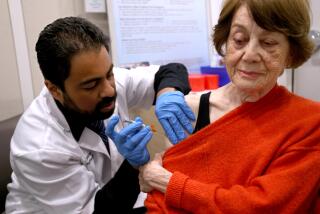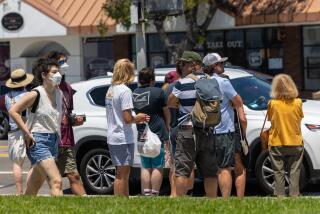Worst flu season in years swamps California: ‘Particularly long and difficult’

- Share via
The worst flu season in years is swamping California, prompting a renewed surge in hospitalizations as officials warn the disease could continue circulating at high levels for weeks to come.
By one measure, this season has already been more potent than any seen since the onset of the COVID-19 pandemic in early 2020, according to data from the California Department of Public Health. The rate at which flu tests returned positive results at the state’s clinical sentinel labs surged to 27.8% for the week ending Feb. 1, the most recent for which complete data are available.
That’s higher than the peak of the “tripledemic” winter of 2022-23, when California’s hospitals were stressed by simultaneous high circulation of flu, COVID and respiratory syncytial virus, or RSV.
“We’re still on the way up,” Dr. Peter Chin-Hong, an infectious-disease expert at UC San Francisco, said of flu. Since the pandemic began, he said, “this is the first time that we’re mainly talking about flu rather than COVID.”

There have been at least 10 pediatric flu deaths this season in California, according to data from the Department of Public Health. That includes three teenagers in San Diego County.
“These recent flu deaths among our youth are tragic and concerning as we head into what historically is the peak of flu season,” Dr. Ankita Kadakia, the county’s interim public health officer, said in a statement.
None of the teens had received a flu vaccine, which Kadakia said remains “the best protection against getting seriously sick.” Nationally, the U.S. Centers for Disease Control and Prevention estimates there have been at least 11,000 deaths from flu this season, including 47 children, and at least 250,000 hospitalizations.
“I think in COVID, we got used to the idea that kids are, quote-unquote, fine,” Chin-Hong said. Flu, however, “can be very severe in kids. Pediatricians are telling me that they’re seeing tons of flu in kids right now.”
Complicating matters has been an unusually low vaccination rate against flu for children this winter — the lowest since at least the 2019-20 season. Nationally, 44.5% of children age 17 and younger were vaccinated against flu as of late January, down from 49.1% at the same time last year and 51.7% from the year before.

The trend is similar in California: 47.7% of California’s children have been vaccinated against flu as of late January, also the lowest since at least the 2019-20 flu season. Last year at this time, 53.7% of children were vaccinated against flu.
The CDC recommends everyone 6 months or older get a flu shot — ideally by the end of October to boost protection against the disease during high-circulation winter months.
But given how potent this flu season has already proved to be, officials say those who have yet to be vaccinated should consider doing so.
“This has been a particularly long and difficult flu season compared to recent years. And it’s not over yet,” Kadakia said.
The two types of flu generally circulating now are H1N1 — related to the swine flu strain that caused a flu pandemic in 2009 and 2010 — and H3N2, which “is notorious for just causing more serious illness in general,” Chin-Hong said. Of about 3,500 influenza type A viruses genetically analyzed nationally over a recent week among public health labs, 54% were H1N1 and 46% were H3N2.
There were no bird flu viruses identified in humans that week. Health officials say the current risk to the public from bird flu remains low, as no person-to-person spread has been detected. Nationwide, 68 human cases have been confirmed, including 38 in California. The vast majority of those cases are associated with exposure to infected poultry or cattle.
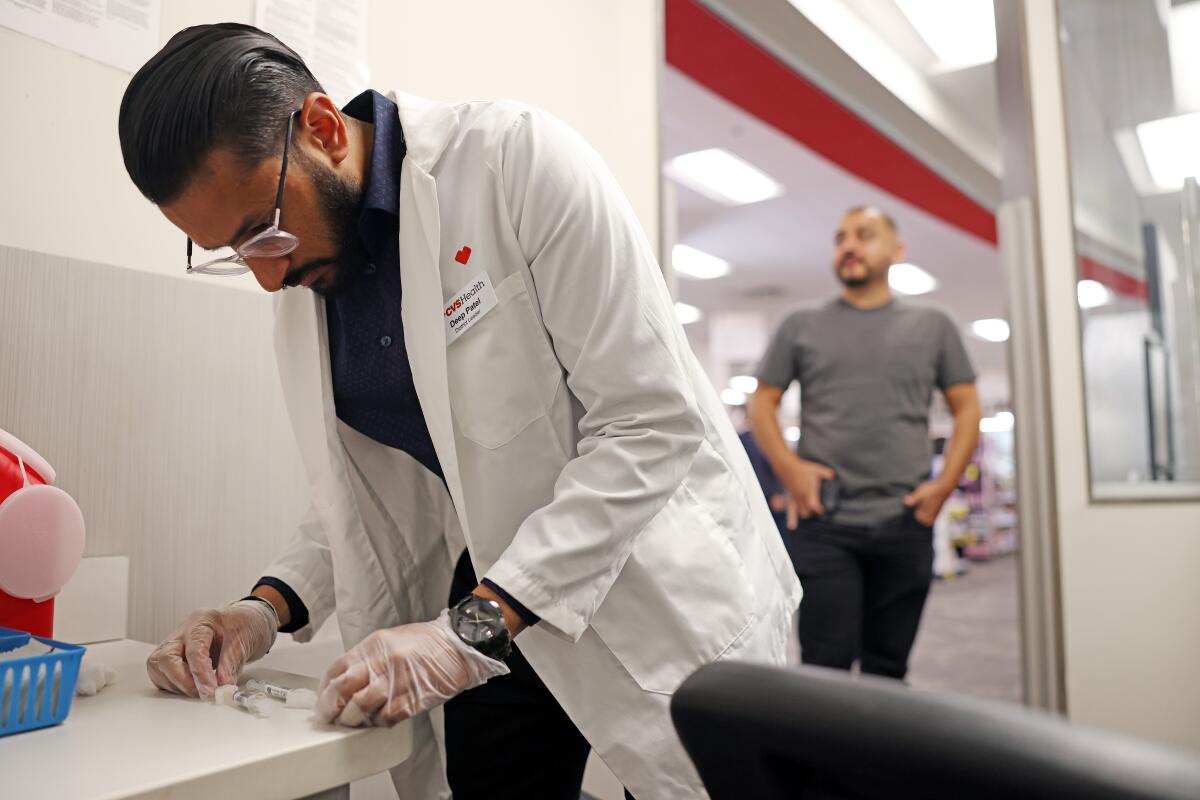
Overall, flu activity “is high and increasing,” California health officials said in their latest respiratory virus weekly report, but they are not seeing similarly concerning spread of either COVID or RSV at the moment.
COVID activity is low statewide, and RSV activity is low and decreasing. The most recent test positive rate for COVID was 2.4%, and for RSV, 5%.
Some experts caution that the test positivity rate isn’t necessarily the best metric to compare flu seasons with one another, as testing practices and healthcare usage vary from season to season.
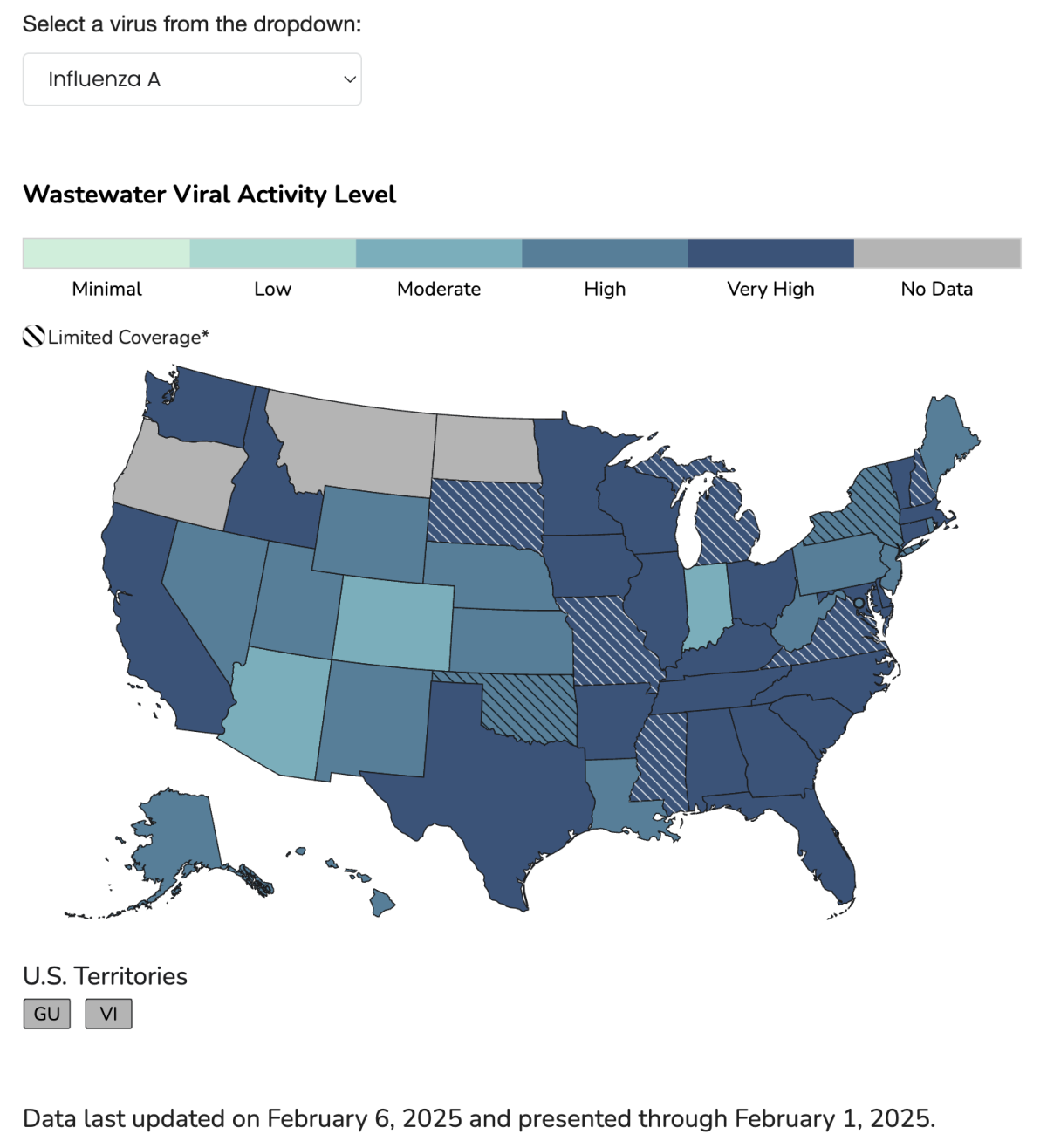
Levels of flu detected through surveillance in California’s wastewater are “very high,” as is the case in most other states, data show. In California, RSV levels are considered “high,” while COVID levels are considered low.
California’s rate of hospital admissions from flu is also on the rise, possibly indicating a second peak of the winter. According to the latest state report, the hospitalization rate had climbed to 10.1 new admissions per 100,000 people, the highest mark of the season.

“Influenza predictions suggest that emergency department visits will remain high and may increase in most states,” the CDC said.
At UC San Francisco, staffers got an alert that the hospital is full, “and I haven’t seen that for a while,” Chin-Hong said. “A lot of people have flu in the hospital, so that could be part of it.”
The situation is much the same in Los Angeles County, where this winter’s flu season appears to be the most durable and potent of the post-COVID-emergency era.
The test positivity rate for flu has been above 20% for seven straight weeks in L.A. County and rose to 28.83% for the most recent week available.
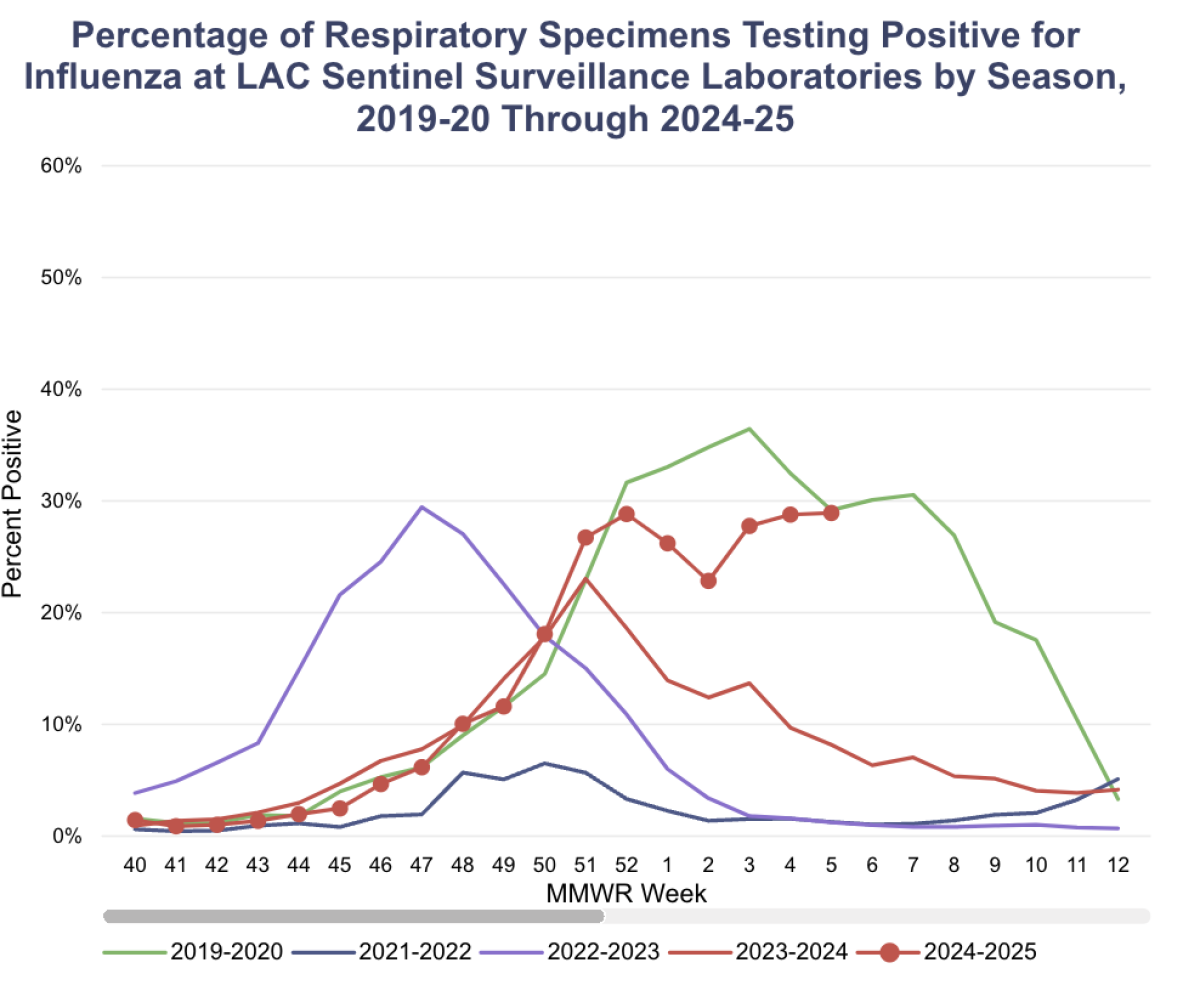
The last time there was such a sustained surge in positive flu tests was during the 2019-20 season, where there were 10 straight weeks the test positivity rate for flu was above 20%.
Nationwide, emergency room visits are very high for flu and moderate for RSV, according to the CDC. But they’re low for COVID-19.
The rate at which flu tests are coming back positive nationally is 31.6% and has been increasing. The RSV test positive rate is 6.6% and decreasing. The COVID test positivity rate is also decreasing and was at 4.9%, as of the last report issued Friday.
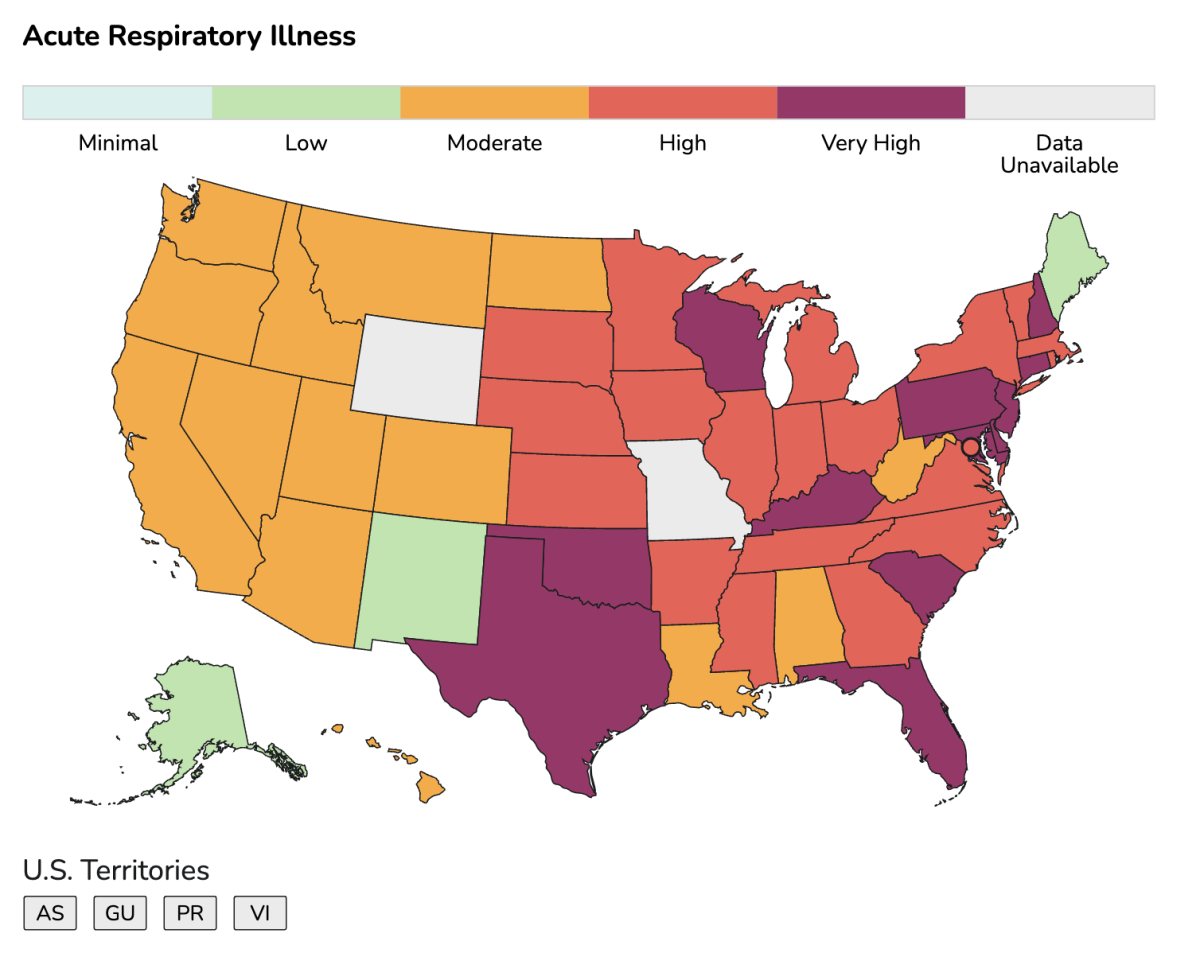
“COVID predictions for the next two weeks suggest that emergency department visits will remain at a lower level compared to prior winter seasons,” the CDC said.
Should that trend hold, this would be the first winter of the COVID era in which California does not see a pronounced surge of the disease.
“The late surge of COVID seen last summer and early fall likely decreased the portion of the population susceptible to COVID-19 this winter,” the L.A. County Department of Public Health said in a statement.
Also possibly helping matters, Chin-Hong said, was that a new blockbuster COVID subvariant has not emerged in recent months.
The overall level of respiratory illnesses — including flu, COVID and RSV — is worst in the eastern U.S. Levels of respiratory illness are considered moderate in California and much of the West.
Vaccines for COVID and RSV are also available, and health officials recommend residents, particularly those at high risk of developing severe symptoms, consider getting those shots as well. RSV immunizations were first approved for use in the U.S. in 2023.
All those 6 months and older are recommended to get the COVID vaccination that was updated in the fall. An RSV vaccine is recommended for all adults age 75 and up, and those ages 60 to 74 who are at increased risk. To prevent severe RSV in infants, officials recommend either maternal vaccination or immunizing the infant with a monoclonal antibody.
“With respiratory infections circulating in our community this time of year, it is more important than ever for people to get a flu vaccine, as well as an updated COVID-19 vaccine and the RSV vaccine if you are eligible,” Dr. Rais Vohra, Fresno County’s interim health officer, said in a statement.
A report published in the CDC’s Morbidity and Mortality Weekly Report in October noted that flu vaccination rates have declined in other countries, including in South America, where they were below pre-pandemic norms.
“This finding is consistent with postpandemic declines in vaccination coverage across the Americas associated with vaccine misinformation, hesitancy and disruptions in routine immunization services,” the report said.
Some health experts have expressed alarm about the rise in skepticism surrounding vaccine safety — including from Robert F. Kennedy Jr., President Trump’s nominee to run the U.S. Department of Health and Human Services. Health experts say the nation’s recommended vaccines are safe.
“I just wonder if it’s part of a general, you know, with RFK Jr. all that stuff, just more questions about vaccines,” Chin-Hong said. The reduction in flu vaccination rates among children, he added, “that is kind of striking to me.”
More to Read
Sign up for Essential California
The most important California stories and recommendations in your inbox every morning.
You may occasionally receive promotional content from the Los Angeles Times.
